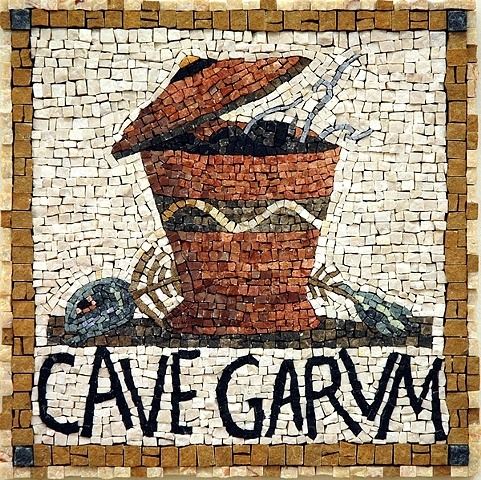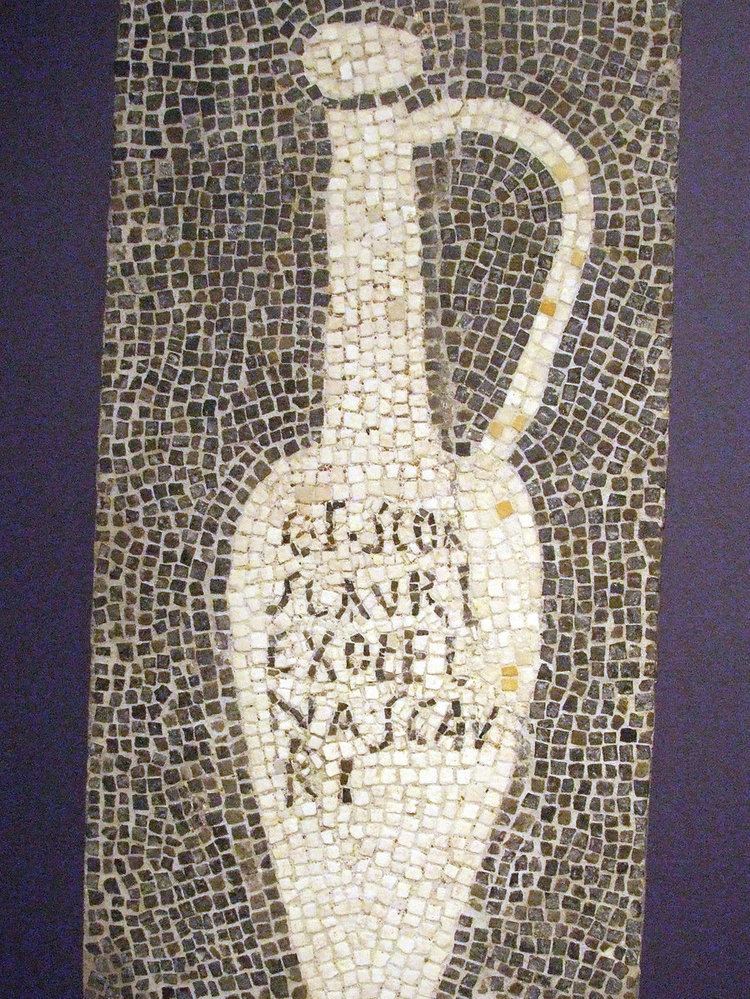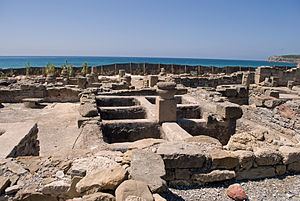 | ||
Similar Colatura di Alici, Fish sauce, Defrutum, Salting, Moretum | ||
Garum sauce by heston blumenthal
Garum was a fermented fish sauce used as a condiment in the cuisines of ancient Greece, Rome, and Byzantium. Liquamen was a similar preparation, and at times the two were synonymous. Although it enjoyed its greatest popularity in the Roman world, the sauce was earlier used by the Greeks.
Contents

Manufacture and export

Pliny the Elder and Isidore of Seville derive the Latin word garum from the Greek γαρός (garos), a food named by Aristophanes, Sophocles, and Aeschylus. Garos may have been a type of fish, or a fish sauce similar to garum. Pliny stated that garum was made from fish intestines, with salt, creating a liquor, the garum, and a sediment named (h)allec or allex. A concentrated garum evaporated down to a thick paste with salt crystals was called muria; it would have been rich in protein, amino acids, minerals and B vitamins.

Like the modern fermented soy product soy sauce, fermented garum is rich in the natural amino acid monosodium glutamate, a source of umami flavoring. It was used along with murri in medieval Byzantine and Arab cuisine to give a savory flavor to dishes. Murri may well derive from garum.

Garum was produced in various grades consumed by all social classes. After the liquid was ladled off of the top of the mixture, the remains of the fish, called allec, was used by the poorest classes to flavour their staple porridge or farinata. The finished product—the nobile garum of Martial's epigram—was apparently mild and subtle in flavor. The best garum fetched extraordinarily high prices, and salt could be substituted for a simpler dish. Garum appears in many recipes featured in the Roman cookbook Apicius. For example, Apicius (8.6.2–3) gives a recipe for lamb stew, calling for the meat to be cooked with onion and coriander, pepper, lovage, cumin, liquamen, oil, and wine, then thickened with flour.

In the 1st century AD, liquamen was a sauce distinct from garum, as indicated throughout the Corpus Inscriptionum Latinarum IV. By the 5th century or earlier, however, liquamen had come to refer to garum. The available evidence suggests that the sauce was typically made by crushing the innards of (fatty) pelagic fishes, particularly anchovies, but also sprats, sardines, mackerel or tuna, and then fermenting them in brine. In most surviving tituli picti inscribed on amphorae, where the fish ingredient is shown, the fish is mackerel.
The manufacture and export of garum was an element of the prosperity of coastal Greek emporia from the Ligurian coast of Gaul to the coast of Hispania Baetica, and perhaps an impetus for Roman penetration of these coastal regions. In the ruins of Pompeii, jars were even found containing kosher garum, suggesting an equal popularity among Roman Jews. Each port had its own traditional recipe, but by the time of Augustus, Romans considered the best to be garum from Cartagena and Gades in Baetica. This product was called garum sociorum, "garum of the allies". The ruins of a garum factory remain at the Baetian site of Baelo Claudia (in present-day Tarifa) and Carteia (San Roque). Garum was a major export product from Hispania to Rome, and gained the towns a certain amount of prestige. The garum of Lusitania (in present-day Portugal) was also highly prized in Rome, and was shipped directly from the harbour of Lacobriga (Lagos). A former Roman garum factory can be visited in the Baixa area of central Lisbon. Fossae Marianae in southern Gaul, located on the southern tip of present-day France, served as a distribution hub for Western Europe, including Gaul, Germania, and Roman Britain.
Umbricius Scaurus' production of garum was key to the economy of Pompeii. The factories where garum was produced in Pompeii have not been uncovered, perhaps indicating that they lay outside the walls of the city. The production of garum created such unpleasant smells that factories were generally relegated to the outskirts of cities. In 2008, archaeologists used the residue from garum found in containers in Pompeii to confirm the August date of the eruption of Mount Vesuvius. The garum had been made entirely of bogues, fish that congregate in the summer months.
Cuisine
When mixed with wine (oenogarum, a popular Byzantine sauce), vinegar, black pepper, or oil, garum enhances the flavor of a wide variety of dishes, including boiled veal and steamed mussels, even pear-and-honey soufflé. Diluted with water (hydrogarum) it was distributed to Roman legions. Pliny (d. 79) remarked in his Natural History that it could be diluted to the colour of honey wine and drunk.
Social aspects
Garum had a social dimension that might be compared to that of garlic in some modern Western societies, or to the adoption of fish sauce in Vietnamese cuisine (called nước mắm there). Seneca, holding the old-fashioned line against the expensive craze, cautioned against it, even though his family was from Baetian Corduba:
Do you not realize that garum sociorum, that expensive bloody mass of decayed fish, consumes the stomach with its salted putrefaction?
A surviving fragment of Plato Comicus speaks of "putrid garum". Martial congratulates a friend on keeping up amorous advances to a girl who had indulged in six helpings of it.
Garum was also employed as a medicine. It was thought to be one of the best cures for many ailments, including dog bites, dysentery, and ulcers, and to ease chronic diarrhea and treat constipation. Garum was even used as an ingredient in cosmetics and for removal of unwanted hair and freckles.
The biological anthropologist Piers Mitchell suggests that garum may have helped spread fish tapeworms across Europe.
Legacy
Garum remains of interest to historians of food and others. In Southeast Asia, fish sauce remains a distinctive element of that region's cuisine, as garum was in Rome. Ketchup, originally a savory fish sauce that did not contain either sugar or tomatoes, shared its origins, culinary functions and popularity with garum. Garum is believed to be the ancestor of the fermented anchovy sauce, colatura di alici, still produced in Campania, Italy.
